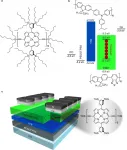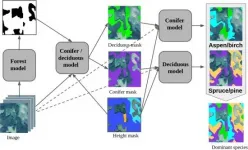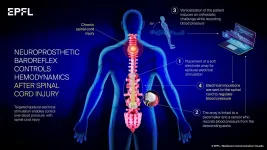(Press-News.org) Advances in DNA sequencing have uncovered a rare syndrome which is caused by variations in the gene SATB1.
The study, co-authored by academics from Oxford Brookes University (UK), University of Lausanne (Switzerland), Radboud University (The Netherlands), University of Oxford (UK), University of Manchester (UK) and led by Max Planck Institute for Psycholinguistics (The Netherlands), discovered three classes of mutations within the gene SATB1, resulting in three variations of a neurodevelopmental disorder with varying symptoms ranging from epilepsy to muscle tone abnormalities.
Recognition of disorder will increase understanding and diagnosis
An international team of geneticists and clinicians from 12 countries identified 42 patients with mutations in the gene SATB1 who were all displaying a range of similar symptoms, albeit of varying severity.
Variations, or mutations, of SATB1 were found to have different effects in the cell. For example, some variations led to increased activity of the protein which causes a more severe type of disorder, while other variations cause loss of function of the gene and lead to less severe difficulties.
The SATB1-syndrome is characterised by neurodevelopmental delay, intellectual disability, muscle tone abnormalities, epilepsy, behavioural problems, facial dysmorphism and dental abnormalities.
Dr Dianne Newbury, Senior Lecturer in Medical Genetics and Genomics at Oxford Brookes University said: "Previously, just one or two cases of patients with SATB1 variations had been described but it was not recognised as a specific syndrome. Patients displaying these characteristics and their families, will have known that they had an undefined neurological condition, but they wouldn't have known any specific detail about the condition, or why they had it.
"We hope that the recognition of this new disorder, and the information about the molecular pathways contributing to it, will help the families and individuals affected understand more about the condition and achieve a diagnosis they would not have had previously."
Three classes of mutation have different effects in the cell
The mutations found in the genome of the patients were found to belong to three different classes. The first mutation class, identified in eight patients, caused a loss of function of the SATB1 gene and halved the production of the encoded protein. This leads to a less severe syndrome characterised by diminished cognitive function, visual problems and facial dysmorphism.
The second class contains four mutations, which encode shorter proteins that are less efficient as they are not positioned correctly in the cell. This second mutation shows as an intermediary syndrome, characterised as more severe than the first, but less severe than the third.
The third class of variation encompasses the mutations found in the last thirty patients. These modify the encoded protein, making it more active. This altered protein is 'sticky' and binds better to DNA, diminishing the expression of genes it regulates and causing a more severe type of disorder, characterised by severe intellectual disability, epilepsy, a motor speech disorder (dysarthria) and specific facial features.
Understanding mutations is key to discovering the origin of genetic diseases
Dr Alexandre Reymond, Director of the Center for Integrative Genomics at the University of Lausanne in Switzerland said: "These results demonstrate that each mutation is different and that is essential to understand their mode of action in order to explain the origin of genetic diseases.
"We must go beyond sequencing, which is only a first step."
INFORMATION:
The paper, Mutation-specific pathophysiological mechanisms define different neurodevelopmental disorders associated with SATB1 dysfunction, has been published in The American Journal of Human Genetics.
People with sleep disorders commonly have a misperception about their actual sleep behaviour. A research group led by Karin Trimmel and Stefan Seidel from MedUni Vienna's Department of Neurology (Outpatient Clinic for Sleep Disorders and Sleep-Related Disorders) analysed polysomnography results to identify the types of sleep disorder that are associated with a discrepancy between self-reported and objective sleep parameters and whether there are any factors that influence this. The main finding: irrespective of age, gender or screening setting, insomnia patients are most likely to underestimate how long they sleep. The study has been published in the highly regarded Journal of Clinical Sleep Medicine.
Patients' misperceptions about the actual time that they sleep is a well-known ...
The ability to manipulate near-infrared (NIR) radiation has the potential to enable a plethora of technologies not only for the biomedical sector (where the semitransparency of human tissue is a clear advantage) but also for security (e.g. biometrics) and ICT (information and communication technology), with the most obvious application being to (nearly or in)visible light communications (VLCs) and related ramifications, including the imminent Internet of Things (IoT) revolution. Compared with inorganic semiconductors, organic NIR sources offer cheap fabrication over large areas, mechanical flexibility, conformability, ...
Mass spectrometers are widely used to analyze highly complex chemical and biological mixtures. Skoltech scientists have developed a new version of a mass spectrometer that uses rotation frequencies of ionized molecules in strong magnetic fields to measure masses with higher accuracy (FT ICR). The team has designed an ion trap that ensures the utmost resolving power in ultra-strong magnetic fields. The research was published in the journal Analytical Chemistry.
The ion trap is shaped like a cylinder made up of electrodes, with electric and magnetic fields generated inside. The exact masses of the test sample's ions can be determined from their rotation frequencies. The electrodes must create a harmonized field of a particular shape ...
Skoltech researchers and their colleagues from Russia and Germany have designed an on-chip printed 'electronic nose' that serves as a proof of concept for low-cost and sensitive devices to be used in portable electronics and healthcare. The paper was published in the journal ACS Applied Materials Interfaces.
The rapidly growing fields of the Internet of Things (IoT) and advanced medical diagnostics require small, cost-effective, low-powered yet reasonably sensitive, and selective gas-analytical systems like so-called 'electronic noses.' These ...
A genetic engineering method makes it possible to observe how woody cell walls are built in plants. The new research in wood formation, conducted by the University of Copenhagen and others, opens up the possibility of developing sturdier construction materials and perhaps more climate efficient trees.
The ability of certain tree species to grow taller than 100 meters is due to complex biological engineering. Besides needing the right amounts of water and light to do so, this incredible ability is also a result of cell walls built sturdily enough to keep a tree both upright and able to withstand the tremendous pressure created as water is sucked up from its roots and into its leaves.
This ability is made possible by what are known as the secondary cell ...
Skoltech scientists have developed an algorithm that can identify various tree species in satellite images. Their research was published in the IEEE Journal of Selected Topics in Applied Earth Observations and Remote Sensing.
Identifying tree species is essential for efficient forest management and monitoring. Satellite imagery is an easier and cheaper way to deal with this task than other approaches that require ground observations of vast and remote areas.
Researchers from the Skoltech Center for Computational and Data-Intensive Science and Engineering (CDISE) and Skoltech Space Center used a neural network to automate dominant tree species' identification in high and medium resolution images. A hierarchical classification model and additional data, such as vegetation height, helped ...
People with combined vision and hearing loss are nearly four times more likely to experience depression and more than three times more likely to suffer chronic anxiety, according to a new study published in the journal Frontiers in Psychology and led by Anglia Ruskin University (ARU).
Researchers analysed a health survey of 23,089 adults in Spain and found that while people suffering either vision or hearing loss both were more likely to report depression as those that were not, that risk increased to 3.85 times higher when respondents reported problems with both senses combined.
The study also found people with combined vision and hearing loss were 3.38 times more likely than the general population to report chronic anxiety.
It is understood to be the first study looking at ...
An international team of scientists headed by Grégoire Courtine at EPFL and CHUV and Aaron Phillips at the University of Calgary has developed a treatment that can dramatically improve the lives of patients with a spinal cord injury.
VIDEO: https://www.youtube.com/watch?v=UGXnuHgDWFU
"A serious and underrecognized result of these injuries is unstable blood pressure, which can have devastating consequences that reduce quality of life and are life threatening. Unfortunately, there are no effective therapies for unstable blood pressure after spinal cord injury". said Dr. Aaron Phillips, co-lead author of the study (see affiliations below). ...
Thursday, 28 January 2021: A study has found that adolescents who frequently use cannabis may experience a decline in Intelligence Quotient (IQ) over time. The findings of the research provide further insight into the harmful neurological and cognitive effects of frequent cannabis use on young people.
The paper, led by researchers at RCSI University of Medicine and Health Sciences, is published in Psychological Medicine.
The results revealed that there were declines of approximately 2 IQ points over time in those who use cannabis frequently compared to those who didn't use cannabis. Further analysis suggested that this decline in IQ points was primarily related to reduction in verbal IQ.
The research involved systematic review and statistical analysis on seven longitudinal studies ...
New insight into how human brains detect and perceive different types of touch, such as fluttery vibrations and steady pressures, has been revealed by UCL scientists with the help of the ancient Chinese cooking ingredient, Szechuan pepper.
Humans have many different types of receptor cells in the skin that allow us to perceive different types of touch. For more than a century, scientists have puzzled over whether touch signals from each type of receptor are processed independently by the brain, or whether these different signals interact before reaching conscious perception.
For the study, published in Proceedings of the Royal Society B, UCL researchers took a novel approach to this question by stimulating one type of touch receptor chemically, and another type mechanically. ...






